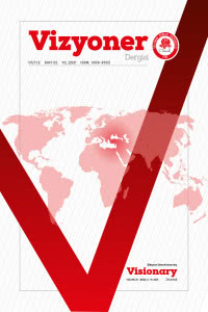Medya Endüstrisinde Sanal Etkileyicilerin Konumu: İnstagram Örneği Üzerinden Bir Değerlendirme
Medya Endüstrisi, Medya Ekonomisi, Sosyal Medya, Instagram, Sanal Etkileyiciler
The State of Virtual Influencers in the Media Industry: An Evaluation Over Instagram Example
Media Industry, Media Economy, Social Media, Instagram, Virtual Influencers,
___
- Albarran, A.B. (2010). The media economy. Routledge
- Alexander, A., vd. (2004). Media Economics Theory and Practice. Lawrence Erlbaum Associates, Publishers.
- Alphabet Inc. (2022). 2021 faaliyet raporu. https://abc.xyz/investor/ adresinden 20 Kasım 2022 tarihinde alınmıştır.
- Arsenyan, J. ve Mirowska, A. (2021). Almost human? A comparative case study on the social media presence of virtual influencers. International Journal of Human-Computer Studies, 155, 102694.
- Awdziej, M., Plata-Alf, D. ve Tkaczyk, J. (2022). Real or not, doesn’t matter, as long as you are hot: Exploring the perceived credibility of an Instagram virtual influencer, M. Awdziej ve J. Tkaczyk, (Ed.), Extending boundaries, The impact of the digital world on consumers and marketing içinde (s.33-46). Kozminski University.
- Aziz, A. (2020). Sosyal bilimlerde araştırma yöntemleri ve teknikleri. Nobel.
- Bagdikian, B.H. (2004). The new media monopoly. Beacon Press.
- Berryman, R., Abidin, C. ve Leaver, T. (2021). A topography of virtual influencers. AoIR Selected Papers of Internet Research. https://journals.uic.edu/ojs/index.php/spir/article/view/12145 adresinden 15 Kasım 2022 tarihinde alınmıştır.
- Bilgici Oğuz, C. ve Özkök Şişman, Ö. (2022). Sanal etkileyicilerin sosyal medya paylaşımlarının antropomorfik biçimler bağlamında incelenmesi. TRT Akademi, 7(14), 104-133.
- Bozacı, İ. ve Bulat, F. (2020). Instagram sanal etkileyicileri ile moda pazarlaması: Bir içerik analizi. Turkish Online Journal of Design Art and Communication, 10(4), 468-478.
- Brown, D. ve Heyes, N. (2008). Influencer marketing who really influences your customers. Butterworth-Heinemann.
- Cha, J., (2013). Business models of most visited U.S. social network sites. A.B. Albarran (Ed.), The social media industries içinde (s. 60-86). Routledge.
- Conti, M., Gathani J. ve Tricomi, P. P. (2022). Virtual influencers in online social media. IEEE Communications Magazine, 60(8), 86-91.
- Dergipark. (2023). https://dergipark.org.tr/tr/search?q=sanal+etkileyici§ion=articles adresinden 12 Haziran 2023 tarihinde erişilmiştir.
- Doyle, G. (2013). Understanding media economics. Sage.
- Gedik, Y. (2020). Sosyal medyada yükselen bir trend: Influencer pazarlama üzerine kavramsal bir değerlendirme. Pamukkale Üniversitesi İşletme Araştırmaları Dergisi, 7(2), 362-385. https://doi.org/10.47097/piar.825325
- Geyser, W. (2022, 2 Mart). The state of influencer marketing benchmark report 2022. Influencer Marketing Hub. https://influencermarketinghub.com/influencer-marketing-benchmark-report/ adresinden 13 Kasım 2022 tarihinde alınmıştır.
- Google Akademik. (2023). https://scholar.google.com/scholar?hl=tr&as_sdt=0%2C5&q=virtual+influencers&btnG=&oq= adresinden 12 Haziran 2023 tarihinde alınmıştır.
- Kara, T. (2013). Sosyal medya endüstrisi. Beta.
- Karasar, N. (2012). Bilimsel araştırma yöntemi. Nobel Yayıncılık.
- Küng, L. (2017). Strategic management in the media theory to practice. Sage.
- Meta. (2022). 2021 faaliyet raporu. https://investor.fb.com/financials/sec-filings-details/default.aspx?FilingId=15526422 adresinden 20 Kasım 2022 tarihinde alınmıştır.
- Microsoft Corporation. (2022). 2021 faaliyet raporu. https://www.microsoft.com/en-us/Investor/sec-filings.aspx adresinden 20 Kasım 2022 tarihinde alınmıştır.
- Moustakas, E. N., Mahmoud, L. D. ve Ranganathan, C. (2020). Blurring lines between fiction and reality: Perspectives of experts on marketing effectiveness of virtual influencers. 2020 International Conference on Cyber Security and Protection of Digital Services (Cyber Security), 1-6.
- Picard, R. G. (2006). Historical trends and patterns in media economics. A. B. Albarran, S. M. Chan-Olmsted ve M. O. Wirth (Ed.), Handbook of Media Management and Economics içinde (s. 23-36). Lawrence Erlbaum Associates Publishers.
- Picard, R.G. (2011). The economics and financing of media companies. Fordham University Press.
- Picard, R. (1988). Introduction. Journal of Media Economics, 1(1).
- PricewaterhouseCoopers. (2022). Perspectives from the global entertainment & media outlook 2022–2026. https://www.pwc.com/gx/en/industries/tmt/media/outlook/outlook-perspectives.html adresinden 21 Kasım 2022 tarihinde alınmıştır.
- PwC ve IAB. (2022). Internet advertising revenue report full year 2021 results. https://www.iab.com/wp-content/uploads/2022/04/IAB_Internet_Advertising_Revenue_Report_Full_Year_2021.pdf adresinden 17 Kasım 2022 tarihinde alınmıştır.
- Santora, J. (2021, 17 Haziran). What are virtual influencers and how do they work? Influencer Marketing Hub. https://influencermarketinghub.com/what-are-virtual-influencers/#toc-3 adresinden 12 Kasım 2022 tarihinde alınmıştır.
- Sardarizadeh, S. (2022, 12 Kasım). Twitter chaos after wave of blue tick impersonations. British Broadcasting Corporation. https://www.bbc.com/news/technology-63599553 adresinden 18 Kasım 2022 tarihinde alınmıştır.
- Schwarz, R. (2022, 23 Mayıs). Should marketer leverage virtual influencers. Forbes. https://www.forbes.com/sites/forbescommunicationscouncil/2022/05/23/should-marketers-leverage-virtual-influencers/?sh=1613d9854b6a adresinden 15 Kasım 2022 tarihinde alınmıştır.
- Statista. (2022, 17 Haziran). Leading platforms where consumers follow virtual influencers in the United States as of March 2022. https://www.statista.com/statistics/1303988/top-platforms-consumers-follow-virtual-influencers-us/ adresinden 18 Kasım 2022 tarihinde alınmıştır.
- Steele, (2022, 9 Şubat). Virtual influencers could earn millions in 2022. PC Magazine. https://www.pcmag.com/news/virtual-influencers-could-earn-millions-in-2022 adresinden 20 Kasım 2022 tarihinde alınmıştır.
- Tanyeri, E. ve Toprak, H. (2020). Nüfuz pazarlaması (influencer marketing) ve satın alma davranışı ilişkisi: Sosyal ağ kullanıcıları üzerinden bir araştırma. OPUS International Journal of Society Researches, 16 (31), 4265-4288. https://dergipark.org.tr/tr/pub/opus/issue/57675/714203 adresinden 17 Kasım 2022 tarihinde alınmıştır.
- The Influencer Marketing Factory. (2022, 29 Mart). Virtual influencers survey + infographic. https://theinfluencermarketingfactory.com/virtual-influencers-survey-infographic/ adresinden 20 Kasım 2022 tarihinde alınmıştır.
- Twitter Inc. (2022). 2021 faaliyet raporu. https://investor.twitterinc.com/financial-information/sec-filings/default.aspx adresinden 20 Kasım 2022 tarihinde alınmıştır.
- Virtualhumans.org. (2022). Virtual influencers. https://www.virtualhumans.org/#influencers adresinden 8 Kasım 2022 tarihinde alınmıştır.
- Wearesocial, (2023). The global state of digital in April 2023. https://wearesocial.com/uk/blog/2023/04/the-global-state-of-digital-in-april-2023/ adresinden 8 Haziran 2023 tarihinde alınmıştır.
- Yahoo Finance. (2022, 8 Mart 2022). Social media global market report. https://finance.yahoo.com/news/social-media-global-market-report-103600484.html adresinden 18 Kasım 2022 tarihinde alınmıştır.
- Zengin Demirbilek, E. (2022). Pazarlamanın dönüşümü ve influencer marketing, https://play.google.com/books/reader?id=QIuaEAAAQBAJ&pg=GBS.PA1&hl=tr adresinden 8 Kasım 2022 tarihinde alınmıştır.
- Zenith. (2021). Advertising expenditure forecasts. https://s3.amazonaws.com/media.mediapost.com/uploads/Advertising_Expenditure_Forecasts_December_2021_0N69DuK.pdf adresinden 11 Kasım 2022 tarihinde alınmıştır.
- Yayın Aralığı: 4
- Başlangıç: 2009
- Yayıncı: Süleyman Demirel Üniversitesi
Uluslararası Ticaretin Teknolojik Dizaynı: Uluslararası Dijital Tedarik Zinciri Örneği
Günseli BOŞGELMEZ, Özgür ÇENGEL
Sokak Sağlıklaştırma Alanında Hazırlanan Tezlerin Bibliyometrik Analizi
Esra ŞAHİN, Hicran Hanım HALAÇ
Ölüm Sonrasına Yönelik Organ Bağışı Tutum Ölçeğinin Türkçe Geçerlilik ve Güvenirlik Çalışması
Eda DALBUDAK ZORKİRİŞÇİ, Ömer Faruk RENÇBER
Medya Endüstrisinde Sanal Etkileyicilerin Konumu: İnstagram Örneği Üzerinden Bir Değerlendirme
